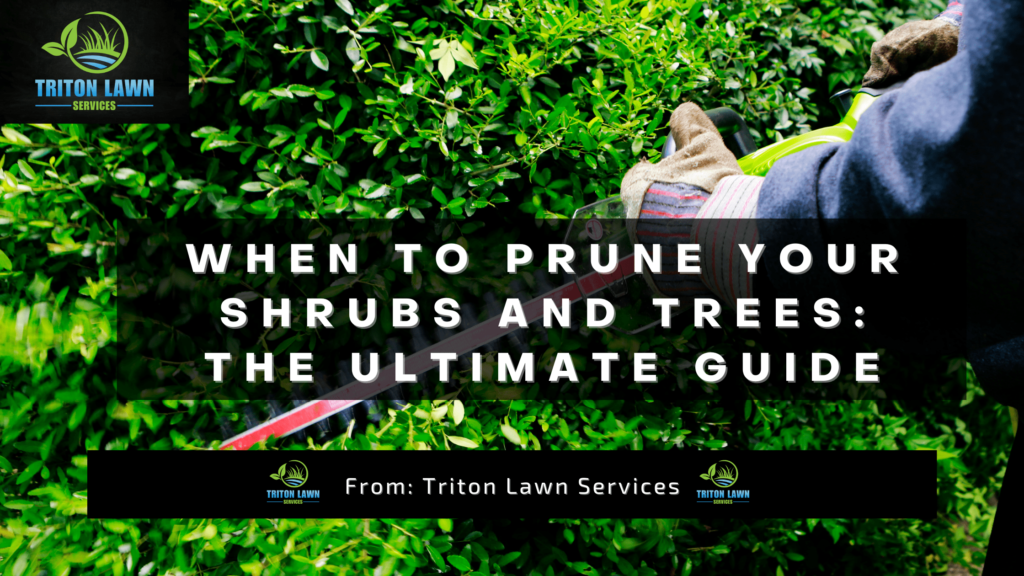When to Prune Your Shrubs and Trees: The Ultimate Guide

From Triton Lawn Services
The gardening task that most gardeners dread, especially those new to gardening, is often pruning plants. It can be overwhelming trying to figure out how and when to begin pruning. The primary concern is that we will take too much of the plant off.
However, pruning is not as difficult or intimidating as one might expect. By the end of this guide, you will have the knowledge and confidence to rein in every unruly plant in your garden.
Why we do it?
Pruning the plants in your garden can bring many benefits. For instance, it encourages new growth, can increase the amount of fruit growing on trees, helps you fight plant diseases, and is one of the main ways to enhance the overall look of your garden.
But the benefits of pruning are not limited to those already mentioned. Read below to find out more about what pruning can do for your garden.
Grow more fruit
Properly pruning a fruit-bearing tree or shrub opens up the canopy, which improves the plant’s ventilation and lets more light shine through.
This gives the plant enough space and energy to grow more buds and flowers in the spring. With its healthy branches and buds, the tree or shrub will be able to produce larger fruits and more of them at a time.
Create a beautiful garden
Pruning has traditionally also been used to alter and improve the shape of plants. When done correctly, this can greatly enhance the decorative qualities of the plants in your garden.
As pruning helps plants divert their energy to the healthiest branches and stems, it can also help them reach their full potential, resulting in vibrant and plentiful blooms.
Grow healthy plants
Leaving diseased or dead leaves and branches on your plants is okay if you hate plants. But, if you want your garden to exude vitality and flourish, you should regularly remove parts that are dead or show signs of disease.
Allowing such plant parts to remain attached is an open invitation for pests, parasites, and diseases to gain a foothold on the already weakened plants.
Restrict the size of plants
may only have a small courtyard, a balcony, or a few window boxes to work with. Pruning plants will allow you to control their size, which also gives you space to grow even more plants.
To make fancy shapes
As mentioned previously, pruning is the best way to mold shrubs and trees into any shape you want.
With time, patience, and proper pruning, you can create some truly marvelous garden masterpieces, ranging from simple shapes to more complicated forms, such as dragons.
Revive old/overgrown plants
A lot of gardens contain at least one old or neglected plant. Many people’s first thought is to uproot the plant and replace it with a younger version.
While this is definitely an option, it is a shame to destroy a well-established plant if it can be brought back to its former glory. Pruning can easily help you achieve this. Removing older branches and stems will give the plant the energy it needs to grow anew.
For safety reasons
Trees with diseased or rotten branches can pose a threat to the health and safety of yourself, your family, and your neighbors.
Falling branches can also cause expensive damage to properties and cars. If you don’t want to remove the entire tree, the best option would be to prune the affected branches.
Pruning plants according to their type
Regardless of how far we have progressed as a species and how much control we can exert over our environment, the fact remains that there is an innate rhythm present in nature.
Working against this natural rhythm in your garden can have disastrous consequences as some plants may die or fail to produce fruit.
Many new gardeners often ask themselves ‘What is the best time to prune?’. Generally, the best time to prune trees and shrubs is in August as most plants have finished growing for the year and there will be enough time for fresh wounds to heal before the colder weather arrives.
However, there are exceptions to this general rule and the most prominent exceptions have to do with the evergreen and deciduous species.
Evergreen trees and shrubs
Evergreens, such as Fir trees, Juniper plants, and Pine trees, are plants that do not lose their leaves during autumn and winter.
The best time to prune members of the evergreen tree and shrub family is in the spring. Pruning them in August, or even closer to winter, will only lead to them dying out in the cold weather.
Deciduous trees and shrubs
Deciduous trees and shrubs are plants that shed their leaves as the weather cools down. Good examples of this are Chestnut trees and Hydrangea shrubs.
The ideal time to prune members of the deciduous family is either at the end of the growing season in August or during the winter months when the plant is in a dormant state.
Avoid pruning flowering and fruit-producing plants in the spring as you run the risk of preventing the plant from blooming or giving fruit.
Prune plants according to their age
The age of plants also plays a vital role in how you prune them. Young plants have different requirements than their older relatives.
Pruning young plants
Pruning from a young age is quite beneficial to plants and is commonly known as formative pruning. It promotes healthy and balanced growth and also allows you to control the general shape in which it will grow into.
Young evergreens do not require pruning while during their development.
- Young deciduous plants benefit greatly from formative pruning during the early stages of growth as they produce a lot of shoots that spread in all directions.
- All young plants can benefit from the removal of overly long or sickly shoots, regardless of their type.
- It is much easier to correct lopsided growth through pruning while the plant is still young.
Pruning old plants
Pruning older plants to revitalise them is best done during the winter while the plant is dormant.
- Start by cutting out any dead, diseased, or crossing stems and branches.
- Next, reduce the number of remaining stems by half.
- You will notice that the plant is much stronger and more vibrant in the following spring.
- Certain shrubs, such as Philadelphus, respond incredibly well to severe pruning. Any plant which responds well to extreme pruning should be cut back to just above ground level. This will let the plant re-establish itself with new shoots.
- If you are not sure if a plant can survive a severe pruning, take a cutting first so that you can easily regrow the plant.
So there we have it, your guide on when to prune your plants. With the right tools and a little bit of common sense, the dreaded task of pruning will not be as scary as you may have thought. Remember to always clean and disinfect your garden tools after use and follow the natural rhythm of the plants in your garden. By doing this and using this guide as a stepping stone, your flourishing garden will soon become the envy of all your neighbours.
